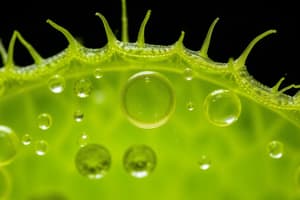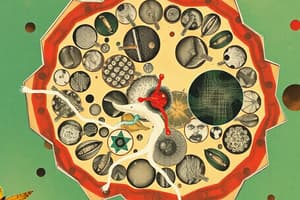Podcast
Questions and Answers
Which of the following organelles is responsible for breaking down cellular waste?
Which of the following organelles is responsible for breaking down cellular waste?
- Lysosomes (correct)
- Mitochondria
- Golgi apparatus
- Vacuoles
What is the primary function of the cell membrane?
What is the primary function of the cell membrane?
- To store genetic information
- To provide structural support to the cell
- To synthesize proteins
- To regulate the movement of molecules into and out of the cell (correct)
Which of the following organelles is found only in plant cells?
Which of the following organelles is found only in plant cells?
- Golgi apparatus
- Chloroplasts (correct)
- Smooth ER
- Mitochondria
What is the primary function of the cell wall?
What is the primary function of the cell wall?
Which of the following organelles is responsible for energy production through cellular respiration?
Which of the following organelles is responsible for energy production through cellular respiration?
Which of the following is NOT a function of the nucleus?
Which of the following is NOT a function of the nucleus?
What is the primary function of the plasma membrane?
What is the primary function of the plasma membrane?
Which of the following is TRUE about the cytoplasm?
Which of the following is TRUE about the cytoplasm?
Which of the following organelles is responsible for protein synthesis?
Which of the following organelles is responsible for protein synthesis?
Which type of ER is involved in protein synthesis?
Which type of ER is involved in protein synthesis?
Which of the following is NOT a characteristic of a prokaryotic cell?
Which of the following is NOT a characteristic of a prokaryotic cell?
What is the function of the nucleolus?
What is the function of the nucleolus?
Which of the following is an example of a unicellular organism?
Which of the following is an example of a unicellular organism?
Flashcards
Smooth ER
Smooth ER
A type of endoplasmic reticulum that lacks ribosomes and is involved in lipid synthesis and detoxification.
Golgi apparatus
Golgi apparatus
Cell organelle that processes and packages proteins and lipids for distribution.
Lysosomes
Lysosomes
Organelles that break down cellular waste and foreign substances using enzymes.
Mitochondria
Mitochondria
Signup and view all the flashcards
Cell membrane
Cell membrane
Signup and view all the flashcards
Cells as the Basic Unit of Life
Cells as the Basic Unit of Life
Signup and view all the flashcards
Unicellular Organisms
Unicellular Organisms
Signup and view all the flashcards
Multicellular Organisms
Multicellular Organisms
Signup and view all the flashcards
Nucleus
Nucleus
Signup and view all the flashcards
Functions of the Nucleus
Functions of the Nucleus
Signup and view all the flashcards
Cytoplasm
Cytoplasm
Signup and view all the flashcards
Organelles
Organelles
Signup and view all the flashcards
Ribosomes
Ribosomes
Signup and view all the flashcards
Study Notes
Cells as the Basic Unit of Life
- Cells are the smallest functional unit of life, responsible for nutrition, interaction with the environment, and reproduction.
- Organisms are classified based on the number of cells:
- Unicellular organisms: Composed of a single cell, like bacteria and protozoa.
- Multicellular organisms: Composed of two or more cells, like animals and plants.
- Most cells have three main parts:
- Nucleus: Controls cellular activities, houses genetic information (except in prokaryotes).
- Plasma: The fluid inside the cell.
- Plasma membrane: The outer barrier of the cell, regulates what enters and exits.
- Other structures can also be found in cells, depending on their type and function. These include:
- Cytoskeleton: Provides structure and support to the cell.
- Organelles: Small structures within the cell that carry out specific functions.
- Cell wall: Provides additional rigidity and protection, found in plants, bacteria, and fungi.
The Nucleus
- The nucleus is a membrane-bound structure that contains the genetic material (DNA) of the cell.
- Functions of the nucleus:
- Coordinates the functions of the cell's organelles.
- Controls the process of cell division.
- Stores the genetic information of the organism.
- Structure of the nucleus:
- Nuclear membrane: The outer layer of the nucleus, controlling what enters and exits.
- Nucleoplasm: The fluid inside the nucleus, containing various structures.
- Nucleolus: Involved in the production of ribosomes.
- Chromatin: Composed of DNA and proteins, forms chromosomes during cell division.
The Cytoplasm
- The cytoplasm is the gel-like substance that fills the cell and contains the organelles.
- Functions of the cytoplasm:
- Provides a medium for cellular activities to occur.
- Facilitates the transport of molecules within the cell.
- In prokaryotes, the cytoplasm contains the genetic material, which is a single DNA molecule.
- The cytoskeleton provides structural support and helps with movement within the cell.
Organelles
- Organelles are specialized structures within the cell that perform specific functions.
- Some of the most important organelles include:
- Ribosomes: Sites of protein synthesis.
- Endoplasmic reticulum (ER): A network of membranes involved in protein and lipid transport and synthesis.
- Rough ER: Contains ribosomes, involved in protein synthesis.
- Smooth ER: Lacks ribosomes, involved in lipid synthesis and detoxification.
- Golgi apparatus: Processes and packages proteins and lipids.
- Lysosomes: Break down cellular waste and foreign substances.
- Mitochondria: Powerhouses of the cell, responsible for energy production through cellular respiration.
- Vacuoles: Storage compartments for water, enzymes, and other molecules.
- Chloroplasts: Sites of photosynthesis in plant cells.
Cell Membrane
- The cell membrane, also known as the plasma membrane, is a thin, flexible layer that surrounds the cell.
- Functions of the cell membrane:
- Creates a barrier between the cell's internal and external environments.
- Regulates the movement of molecules into and out of the cell.
- Enables communication between cells.
Cell Wall
- The cell wall is a rigid structure found outside the cell membrane in plants, bacteria, and fungi.
- Functions of the cell wall:
- Provides structural support and rigidity to the cell.
- Protects the cell from osmotic stress.
- Helps to maintain the cell's shape.
Studying That Suits You
Use AI to generate personalized quizzes and flashcards to suit your learning preferences.




